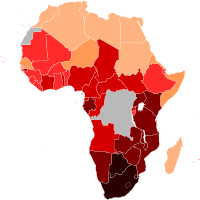
Photo from wikipedia
Despite the global progress in response to HIV and AIDS, notable challenges remain for children, especially identification, linkage, and retention in HIV care and treatment services. To succeed in pediatric… Click to show full abstract
Despite the global progress in response to HIV and AIDS, notable challenges remain for children, especially identification, linkage, and retention in HIV care and treatment services. To succeed in pediatric HIV programming requires the linkage and retention of the children in those services over time. This study assessed the level of retention to antiretroviral therapy (ART) and its associated factors among orphans and vulnerable children living with HIV (OVCLHIV) in Tanzania. Data were obtained from the USAID Kizazi Kipya project that collected pediatric ART data from October 2017 to October 2019 in 81 district councils of Tanzania. Community-based volunteers supported the linkage and retention of the OVCLHIV on ART. Analysis of on-ART status was conducted in a cohort of OVCLHIV aged 0–20 years enrolled in the project and monitored for 24 months. OVCLHIV who remained on ART until the end of the follow-up period were referred to as “retained,” otherwise, “not retained”. Multivariable analysis was conducted using logistic regression, adjusting for baseline characteristics. Of the 5,304 OVCLHIV analyzed, the mean age was 13.1 years, 51.5% were female, and 72.2% were living with female caregivers. Their overall rate of retention on ART over the 24 months was 86.7%. Multivariable analysis showed that as the higher frequency of home visit by the project staff increased, the likelihood of retention increased by 8% [adjusted odds ratio (aOR) = 1.08, 95% CI 1.06–1.11, p < 0.001]. Membership in people living with HIV (PLHIV) support groups was associated with a higher likelihood of retention compared to nonmembership (aOR = 3.31, 95% CI 2.60–4.21, p < 0.001). Children in larger family size were 22% less likely to sustain ART (aOR = 0.78, 95% CI 0.72–0.84, p < 0.001). Urban OVCLHIV were 18% less likely to remain on ART than their rural counterparts (aOR = 0.82, 95% CI 0.69–0.98, p = 0.030). Remaining on ART was 49% more likely for OVC in economically better-off households than those in destitute households (aOR = 1.49, 95% CI 1.22–1.81, p < 0.001). Male OVC were 17% less likely to be retained on ART than their female counterparts (aOR = 0.83, 95% CI 0.71–0.99, p = 0.033). Community-based OVC support resulted in a high pediatric retention rate over the 24 months of follow-up. While key enablers of retention were higher frequency of home visits by the project volunteer, participation in PLHIV support groups, and better economic status, large family sizes, urban place of residence, and male gender of the OVC were barriers. This study brings useful evidence to inform strategies for advancing retention of OVCLHIV on ART for their better health outcomes and overall wellbeing.
Journal Title: Frontiers in Public Health
Year Published: 2022
Link to full text (if available)
Share on Social Media: Sign Up to like & get
recommendations!